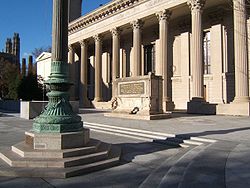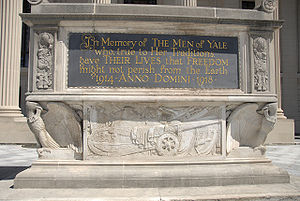
Hewitt Quadrangle
Encyclopedia

Yale University
Yale University is a private, Ivy League university located in New Haven, Connecticut, United States. Founded in 1701 in the Colony of Connecticut, the university is the third-oldest institution of higher education in the United States...
campus in New Haven, Connecticut
Connecticut
Connecticut is a state in the New England region of the northeastern United States. It is bordered by Rhode Island to the east, Massachusetts to the north, and the state of New York to the west and the south .Connecticut is named for the Connecticut River, the major U.S. river that approximately...
, which is the home of the university's administration, main auditorium and dining facilities. Although the official name of the space is Hewitt Quadrangle, it is called Beinecke Plaza nearly universally in any informal context.

Woolsey Hall
Woolsey Hall is the primary auditorium at Yale University. Woolsey Hall, which seats 2,695 people, was built as part of the Yale bicentennial celebration in 1901. The architects were Carrère and Hastings, designers of the New York Public Library....
, and the Memorial Rotunda) were the first buildings constructed for Yale University as opposed to one of its constituent entities (Yale College
Yale College
Yale College was the official name of Yale University from 1718 to 1887. The name now refers to the undergraduate part of the university. Each undergraduate student is assigned to one of 12 residential colleges.-Residential colleges:...
, Sheffield Scientific School
Sheffield Scientific School
Sheffield Scientific School was founded in 1847 as a school of Yale College in New Haven, Connecticut for instruction in science and engineering. Originally named the Yale Scientific School, it was renamed in 1861 in honor of Joseph E. Sheffield, the railroad executive. The school was...
, or others), reflecting a greater emphasis on central administration initiated by Presidents Timothy Dwight
Timothy Dwight V
Timothy Dwight V was an American academic, an educator, a Congregational minister, and president of Yale College...
and Arthur Twining Hadley
Arthur Twining Hadley
Arthur Twining Hadley was an economist who served as President of Yale University from 1899 to 1921.-Biography:...
. Constructed in 1901-2 for the University's bicentennial, the limestone Beaux-Arts buildings linked the College buildings on the Old Campus
Old Campus
The Old Campus is a complex of buildings at Yale University on the block at the northwest end of the green in New Haven, Connecticut, consisting of dormitories, classrooms, chapels and offices...
with the Sheffield Scientific
Sheffield Scientific School
Sheffield Scientific School was founded in 1847 as a school of Yale College in New Haven, Connecticut for instruction in science and engineering. Originally named the Yale Scientific School, it was renamed in 1861 in honor of Joseph E. Sheffield, the railroad executive. The school was...
buildings on Hillhouse Avenue
Hillhouse Avenue
Hillhouse Avenue, described, according to tradition, by both Charles Dickens and Mark Twain as "the most beautiful street in America," , is in New Haven, Connecticut and is home to many nineteenth century mansions including the president's house at Yale University...
. They were designed by John M. Carrère and Thomas Hastings
Thomas Hastings (architect)
Thomas Hastings was an American architect.- Biography :He was born in New York City to Thomas Samuel Hastings, a Presbyterian minister, and Fanny de Groot. Hastings came from a colonial Yankee background, his ancestor Thomas Hastings having come from the East Anglia region of England to the...
.




Newberry Memorial Organ
The Newberry Memorial Organ is among the largest and most notable "orchestral" organs in North America. Located in Woolsey Hall at Yale University, the organ contains 197 ranks and 166 stops comprising 12,617 pipes. It is one of the largest organs in the world....
, a 1928 Skinner organ
Ernest M. Skinner
Ernest M. Skinner was one of the most successful American organ builders of the early 20th century.-Early years:...
. The Rotunda, with tablets on the walls commemorating Yale's war dead is a double-sized, domed, colonnaded version of Bramante's Tempietto
San Pietro in Montorio
San Pietro in Montorio is a church in Rome, Italy, which includes in its courtyard The Tempietto built by Donato Bramante.-History:...
built in 1502 on the site of St. Peter's martyrdom in Rome. Before the colonnade of the Commons is a memorial cenotaph
Cenotaph
A cenotaph is an "empty tomb" or a monument erected in honour of a person or group of people whose remains are elsewhere. It can also be the initial tomb for a person who has since been interred elsewhere. The word derives from the Greek κενοτάφιον = kenotaphion...
. Its inscription reads:
- In Memory of the Men of Yale who true to Her Traditions gave their Lives that Freedom might not perish from the Earth. 1914 Anno Domini 1918.
Behind the cenotaph, one can see inscribed the names of World War I
World War I
World War I , which was predominantly called the World War or the Great War from its occurrence until 1939, and the First World War or World War I thereafter, was a major war centred in Europe that began on 28 July 1914 and lasted until 11 November 1918...
battles of Cambrai
Battle of Cambrai
The Battle of Cambrai was a British campaign of the First World War. Cambrai, in the Nord département , was a key supply point for the German Siegfried Stellung and the nearby Bourlon Ridge would be an excellent gain from which to threaten the rear of the German line to the north...
, Argonne
Meuse-Argonne Offensive
The Meuse-Argonne Offensive, or Maas-Argonne Offensive, also called the Battle of the Argonne Forest, was a part of the final Allied offensive of World War I that stretched along the entire western front.-Overview:...
, Somme, Chateau-Thierry
Battle of Château-Thierry (1918)
The Battle of Château-Thierry was fought on 18 July 1918 and was one of the first actions of the American Expeditionary Force under General John J. "Black Jack" Pershing...
, Ypres
Battle of Ypres
There were five Battles of Ypres during World War I:*First Battle of Ypres *Second Battle of Ypres...
, St. Mihiel
Battle of Saint-Mihiel
The Battle of Saint-Mihiel was a World War I battle fought between September 12–15, 1918, involving the American Expeditionary Force and 48,000 French troops under the command of U.S. general John J. Pershing against German positions...
and Marne
Battle of the Marne
There were two Battles of the Marne, taking place near the Marne River in Marne, France during World War I:* First Battle of the Marne * Second Battle of the Marne...
. Woodbridge Hall, located on the west side of the plaza, was designed by the firm of Howells & Stokes
Howells & Stokes
Howells & Stokes was an American architectural firm. Founded in 1897 by John Mead Howells and Isaac Newton Phelps Stokes, it designed, among other structures, St...
and is French Renaissance in style. It contains
the central administration of the University. The building was named for Reverend Timothy Woodbridge, one of the founders of Yale College.
The visible portion of Beinecke Rare Book and Manuscript Library
Beinecke Rare Book and Manuscript Library
Yale University's Beinecke Rare Book and Manuscript Library was a 1963 gift of the Beinecke family. The building was designed by architect Gordon Bunshaft of the firm of Skidmore, Owings, and Merrill, and is the largest building in the world reserved exclusively for the preservation of rare books...
, on the east side of the plaza, designed by Gordon Bunshaft
Gordon Bunshaft
Gordon Bunshaft was an architect educated at the Massachusetts Institute of Technology. In 1988, Gordon Bunshaft nominated himself for the Pritzker Prize and eventually won it.-Career:...
, is like the visible portion of an iceberg. With three underground levels extending under the plaza, most of the library is hidden. A sunken courtyard, visible but not accessible from the plaza, contains Isamu Noguchi
Isamu Noguchi
was a prominent Japanese American artist and landscape architect whose artistic career spanned six decades, from the 1920s onward. Known for his sculpture and public works, Noguchi also designed stage sets for various Martha Graham productions, and several mass-produced lamps and furniture pieces,...
's sculpture "The Garden (Pyramid, Sun, and Cube)".
As the symbolic heart of the university—and as the space in front of the administration building—Beinecke Plaza is occasionally the site of rallies and protests. These have included labor rallies held by the Federation of Hospital and University Employees
Federation of Hospital and University Employees
The Federation of Hospital And University Employees is a coalition of labor unions in New Haven, Connecticut, United States, which represents thousands of workers at Yale University and Yale-New Haven Hospital...
and their supporters. Student protests have included a 16-day occupation of the plaza by Students Against Sweatshops
United Students Against Sweatshops
United Students Against Sweatshops is a student organization with chapters at over 250 colleges and universities in the United States and Canada. In April 2000, USAS founded the Worker Rights Consortium , an independent monitoring organization that investigates labor conditions in factories that...
in support of an ethical licensing policy (spring 2002). Most notable was the 1986 construction of a shanty-town erected to demand Yale's divestment from apartheid South Africa
South Africa
The Republic of South Africa is a country in southern Africa. Located at the southern tip of Africa, it is divided into nine provinces, with of coastline on the Atlantic and Indian oceans...
. After students erected the shanty-town, designed to mimic a Soweto
Soweto
Soweto is a lower-class-populated urban area of the city of Johannesburg in Gauteng, South Africa, bordering the city's mining belt in the south. Its name is an English syllabic abbreviation for South Western Townships...
shanty and named after Winnie Mandela, the university administration ordered its removal and demolished it. The destruction of the shanty-town, which required the arrest of dozens of protesters, unleashed an outpouring of anger and demands that the shanty-town be recreated. Eventually the university relented and the town was resurrected, only to be burned down by an irate alumnus two years later and replaced by a "memorial wall."
Alexander Calder
Alexander Calder
Alexander Calder was an American sculptor and artist most famous for inventing mobile sculptures. In addition to mobile and stable sculpture, Alexander Calder also created paintings, lithographs, toys, tapestry, jewelry and household objects.-Childhood:Alexander "Sandy" Calder was born in Lawnton,...
's sculpture, "Gallows and Lollipops" stands on the plaza. The Claes Oldenburg
Claes Oldenburg
Claes Oldenburg is a Swedish sculptor, best known for his public art installations typically featuring very large replicas of everyday objects...
sculpture, "Lipstick Ascending on a Caterpillar Tread" (now in Morse College
Morse College
Morse College is one of the twelve residential colleges at Yale University, built in 1961 and designed by Eero Saarinen. It is adjacent to Ezra Stiles College. The current Master is Frank Keil, Professor of Psychology and Professor of Linguistics. The Associate Master is Kristi Lockhart...
) was once on the plaza.

